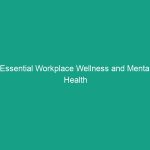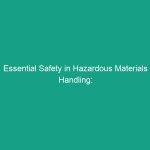Introduction
Good morning team! Today, we are taking a moment to discuss a topic that is critical for our health and well-being at work: Essential HSE Guidelines for a Safer Workplace. Understanding these guidelines is not just a regulatory requirement; it’s a necessity that impacts our daily lives and the Safety of our colleagues. By prioritizing health, safety, and Environment (HSE) standards, we can ensure that everyone returns home unharmed at the end of the day.
Understanding Essential HSE Guidelines
So, what are these Essential HSE Guidelines? Simply put, they are a set of practices and Procedures designed to protect our health, safety, and the environment while we work. These guidelines are crucial for minimizing risks and Hazards that we might face in our workplace.
The importance of these guidelines cannot be overstated. They not only help us avoid workplace accidents but also enhance productivity and morale. A safe work environment boosts confidence, leading to better performance and job satisfaction. Unfortunately, many employees may underestimate the significance of these guidelines, thinking that Safety is a burden or an inconvenience. However, when everyone participates in safety practices, we create a culture of care and responsibility.
Key Hazards, Risks, and Safety Considerations
Let’s delve into some specific hazards and risks associated with neglecting HSE guidelines:
- Slips, Trips, and Falls: These are the most common workplace accidents. Poor housekeeping, wet floors, and cluttered walkways can lead to serious injuries.
- Manual Handling: Lifting heavy objects without proper techniques can result in musculoskeletal injuries, which are often long-lasting.
- Chemical Exposure: Inadequate handling or storage of hazardous substances can lead to serious health issues.
- Equipment Safety: Operating machinery without adequate Training can result in severe injuries or fatalities.
The real-world consequences of ignoring these safety protocols can be devastating—not only for the individuals directly involved but also for their families and the entire workplace. It’s essential to acknowledge that every safety incident has a ripple effect, impacting productivity, morale, and overall company health.
Best Practices, Procedures, & Actionable Advice
Now that we’ve identified some risks, let’s discuss Best Practices that can help mitigate these hazards:
1. Proper Training
Ensure that all employees receive proper training relevant to their roles. This includes:
- Regular safety workshops.
- Hands-on training sessions for equipment Operation.
- Emergency response drills.
2. Use of Personal Protective Equipment (PPE)
Wearing appropriate PPE is crucial. Make sure to:
- Always wear Safety Goggles, gloves, and helmets when required.
- Inspect PPE regularly to ensure it’s in good condition.
- Report any damaged equipment immediately.
3. Maintain Clean Workspaces
A tidy workspace can significantly reduce the risk of accidents. Here are some quick tips:
- Keep walkways clear and free of obstacles.
- Promptly clean up spills to prevent slips.
- Organize tools and materials when not in use.
4. Follow Safety Protocols
Adhere to all Safety Guidelines and protocols. This includes:
- Reporting unsafe conditions or behaviors.
- Participating in safety audits and inspections.
- Staying informed about changes in safety Regulations.
As a real-world example, consider a recent incident where an employee neglected to wear safety goggles while using a cutting machine. The result was a serious eye injury that could have been easily avoided. This highlights the importance of adhering to safety protocols consistently.
Regulations, Standards, and Compliance
Compliance with safety regulations is not optional; it’s a legal requirement. Organizations like OSHA (Occupational Safety and Health Administration) and ISO (International Organization for Standardization) set the Standards that keep us safe. Understanding these regulations is essential because:
- Compliance helps avoid legal penalties.
- It fosters a culture of safety and responsibility.
- It protects the organization from liability in case of accidents.
Following these regulations not only safeguards employees but also enhances the company’s reputation and operational efficiency.
Employee Engagement & Discussion
Your input is invaluable when it comes to Workplace Safety. I encourage you to think about the safety challenges you may have encountered. What safety challenges have you faced related to our guidelines? Sharing your experiences can help us improve our safety practices and foster a culture where everyone feels responsible for each other’s safety.
Conclusion & Key Takeaways
In conclusion, understanding and implementing Essential HSE Guidelines for a Safer Workplace is crucial for our safety and well-being. Remember the key points:
- Stay informed and participate in safety training.
- Always wear appropriate PPE.
- Maintain a clean and organized workspace.
- Adhere to safety protocols and regulations.
By prioritizing safety, we not only protect ourselves but also contribute to a positive workplace culture. Thank you all for your attention and commitment to making our workplace a safer environment. Let’s keep the conversation going and make safety a priority every day!


